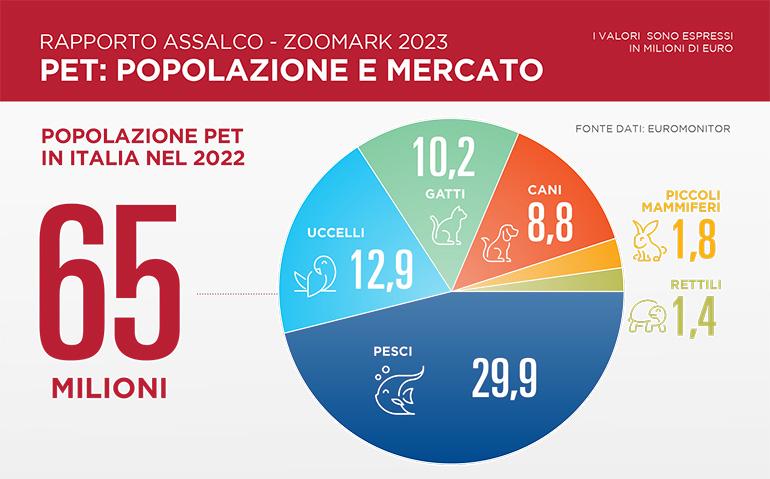Pet food in Italy
Brief notes on the population and on the forms of food packaging for the approximately 65 million pets, guests of Italian families.
Until around ten years ago, our country was well under the European average with regards to the presence of pets. Things have changed, however, especially after the pandemic. The centrality of the relationship with pets is also different from the past, now considered authentic members of the family and for which no expense is spared, even the face of the generalised price increases that are weighing on the population.
According to a recent survey carried out by ASSALCO-ZOOMARK, since 2022 around 65 million pets have been living in our houses, against 60.2 million surveyed in 2019: almost 19 million are dogs and cats, with the latter stable at 10 million. The aquariums of Italian families are populated by almost 30 million fish, while there are 12.88 million of ornamental birds. Small mammals and reptiles number 3.2 million overall.
This all means many mouths to feed, … and here we arrive at the crux of this article: in 2022 around 676,500 tonnes of pet food were sold in Italy, of which 673,400 as food for dogs and cats, which also represents the “hard core” of the value of this market: 2,759.5 million euros out of an overall turnover of around 2,763 million euros.
The trends inside the sector compared to the previous year are positive: +0.8% by volumes and +11.4% by turnover. On the basis of the data analysed by the Italian Packaging Institute’s Data Bank, 21,000 tonnes of packaging were used in this context.
| Tons | Variations | |
|---|---|---|
| Production | 751,482 | 10.90% |
| Import | 248,149 | 0.70% |
| Export | 323,131 | 7.30% |
| Consumption | 676,500 | 4.00% |

Packaging and formats
For pet food as a whole, the prevalence of classic formats both in terms of volume and value is confirmed: the bag is the format characterising the dry foods segment and the can for humid foods.
Again, referring to the Assalco-Zoomark 2023 report, we can note that the “bag and can cover around 86% of market volumes: the bag has grown in value by +2.6% and fallen in volume by -2.5%; the can has both lower volumes (-7.4%) and values (-2.2%). The sachet continues to grow (+10.1% in value, +8.5% in volume) reaching a market value share of 12.3% and is the most dynamic form; the jar has declined (-4.7% in value and -9.5% in volume)”.
Focus on dog and cat food
With reference only to food for dogs and cats, we can see a predominance of flexible packaging with a share of 72,3%: from sachets for small formats to large-size bags that can arrive at 15 kg of contents. These are followed by metal cans at 17.1%. Other types of packaging are: the cardboard box with a share of 4.8% and the paper bag at 3%. Aluminium trays have reached 2.5%, while there is the small amount of 0.3% of rigid laminates, predominantly paper.
| 2002 | 2022 | |
|---|---|---|
| Metal tin | 43.50% | 17.10% |
| Flexible packaging | 6.50% | 72.30% |
| Aluminium tray | 8.80% | 2.50% |
| Cardboard box | 20.50% | 4.80% |
| Paper sack | 20.70% | 3.00% |
| Rigid paper-based laminate | 0.00% | 0.30% |
With regards to dry dog foods, the laminated bag in the so-called “stock size” reigns supreme: from 9 to 15 kg and from 2 to 4 kg (the latter usually reserved for foods for small-sized dogs or characteristic of highly segmented or functional lines). Analysing, instead, the humid foods segment, the most widespread is the metal can of average dimensions between 300 and 600 g, equivalent to a meal for an average-size dog.
Also, with regards to the “cats area”, the most used packaging for dry foods is the laminated bag of from 1 to 2.5 kg. Cans and sachets, in single portion format, almost equally share 90% of the market of humid foods, while the remaining 10% is packaged in aluminium trays.
Barbara Iascone
Italian Packaging Institute





















